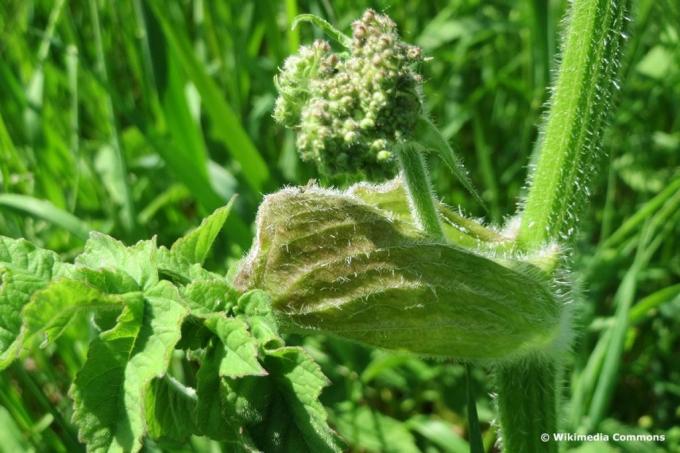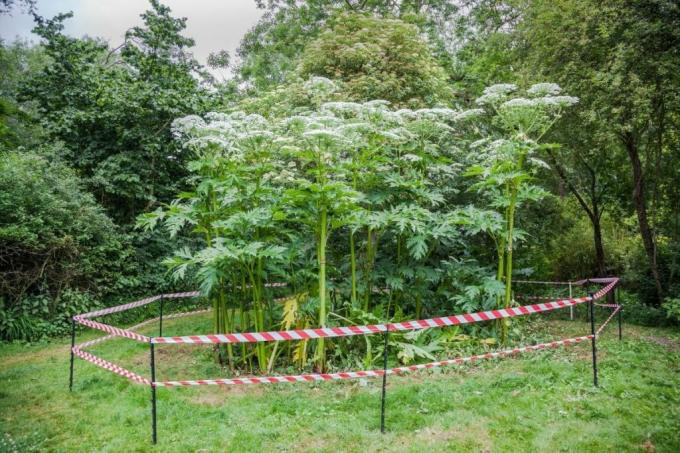
table of contents
- Bear Claw (Heracleum)
- Toxicity
- Identify giant and meadow hogweed
- Meadow hogweed (Heracleum sphondylium)
- Giant hogweed (Heracleum mantegazzianum)
- frequently asked Questions
Meadow hogweed and giant hogweed are widespread in Germany. While the former is classified as slightly poisonous to poisonous, the latter was named poisonous plant of the year in 2008.
In a nutshell
- Meadow hogweed is the little brother of the giant hogweed
- Giant hogweed is very poisonous
- There is a risk of confusion because there are only a few unique features
Bear Claw (Heracleum)
Bear Claw is a genus of plants that includes around 70 species. Of these, only the meadow hogweed and the Austrian hogweed (Heracleum austriacum) are considered native, although they only occur in the Eastern Alps. The type species of the plant genus is the meadow hogweed, i.e. the other species look similar to it, but show more or less great differences. There is a particular risk of confusion in this country with the giant hogweed (Heracleum mantegazzianum). Because this neophyte, which originally comes from the Caucasus, has overgrown gardens and parks and is now on the list of invasive plants in the EU.
Toxicity
Heracleum is poisonous, regardless of whether it is the meadow or giant hogweed. The contained toxins belong to the class of furocoumarins. These can be in sunlight or daylight and when touched phototoxic reactions Trigger (UV-A sensitivity). The symptoms of "meadow dermatitis" are streaky, leaf-shaped or reticulated skin changes that can appear immediately or after one or two days.
In strong sunlight, the following can be seen:
- Redness
- blow
- severe itching
- a spread over arms and legs
In weak sunlight, the following can be seen:
- Redness
- Swelling
- partly without strong inflammatory reactions
However, depending on the strength of the UV-A radiation, the skin heals after one to four weeks. During the healing process, there is strong skin pigmentation, which can show up over many months.
Note: Since the concentration of photosensitizing substances in the giant hogweed is very high, you should avoid or contact this Heracleum species. Wear full protective clothing when handling the plant (incl. Wear face protection.
Identify giant and meadow hogweed
In the following, we will explain the characteristics that can be used to distinguish meadow hogweed from giant hogweed.
Meadow hogweed (Heracleum sphondylium)
Growth:
- perennial herbaceous plant
- Height between 50 and 150 centimeters (depending on the region and location)
- thick, branched main axis
Stem:
- angular furrowed
- hollow
- coarse hairy
- 0.5 to 2 inches thick

Leaves:
- simply feathered
- plump
- slightly hairy
- gray-green
- butt sawed
- incised in uneven lobes
Note: The leaves of the meadow hogweed are large, but they are significantly smaller than those of the giant hogweed.
Blossom:
- double-ended inflorescence with many flowers
- up to 25 centimeters in diameter
- 12 to 40 beams
- Flower color: white and mostly tinged with a light greenish or light pink color
- Flowering period: June to September / October
Giant hogweed (Heracleum mantegazzianum)
The differences in size are emphasized as clear characteristics of the Hercules shrub, as Heracleum mantegazzianum is also called. In other words: in the case of the giant hogweed everything is basically much larger than in the case of the meadow hogweed. Nevertheless, you should orientate yourself on the stem of the plant, because this shows large, dark spots in the giant hogweed.

Growth:
- biennial herbaceous plant
- Growth height in the first year up to 100 centimeters (beginning of May)
- Growth height in the second year up to 300 centimeters (end of June), in rare cases also 500 centimeters
- thick, branched main axis
Note: The Herkulesstaude usually grows two years. The plant only gets older if it does not flower and ripen in the second year.
Stem:
- Difference from meadow hogweed: many, large, wine-red or dark spots
- hardly feared
- hollow
- moderately hairy
- 2 to 10 centimeters thick at the base
(lower) leaves:
- up to 100 centimeters long (with a stem up to 300 centimeters)
- pointed shape, appear rather elongated
- three to nine leaf blades
- sharply sawn
- lateral leaf sections deeply divided, with a length of up to 100 centimeters and a width of more than 20 centimeters
- hairy underside
Blossom:

- Giant bud (surrounded by a wide leaf sheath)
- double-ended inflorescence with many flowers
- 30 to 50 centimeters in diameter
- 30 to 150 beams
- up to 80,000 individual flowers
- Flower color: white
- Flowering period: June to July
frequently asked Questions
There is no obligation to report in Germany. However, since it is an invasive plant that displaces the native vegetation, it is recommended to report the sites to the respective municipality. Ideally, you should send the hogweed expert a photo of the relevant location.
Since the Hercules shrub can sprout as early as February, it has a growth advantage over native plants. The leaves are a good indicator, because they have reached a stately size when the native vegetation only begins to sprout.
The plant makes no special demands on the soil. It grows on banks, on the edge of the forest, meadows, fallow land or pastures. At high altitudes it can be confused with the Austrian hogweed. As this causes similar severe burns, you should stay away from this type as well.
